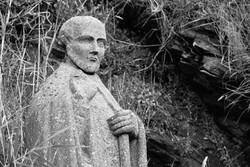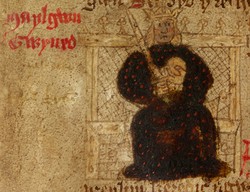There are two versions of Gildas's life, which contradict each other. But they both keep bringing him together with Maelgwn.
In one, Gildas is sent as a child to study under St Illtyd in his monastery. It's the same establishment which received Maelgwn during his own ill-fated period of living under holy orders. Therefore, Gildas and Maelgwn were briefly fellow monks.
No doubt the son of Gwynedd's ruler was invaluable in facilitating any messages passing between the child and his Mum and Dad, back home on Ynys Mon. Could the sudden severing of that channel, when Maelgwn left the monastery, have left a lingering bitterness on the part of Gildas?
In the second version, Gildas didn't become a monk until he was in his thirties. He spent his childhood and young adult life on Ynys Mon, getting married and having children.
Except during Maelgwn's sojourn in the monastery, the two would have continued to live as neighbors. Gildas would have sworn fealty to Maelgwn, when the latter became ruler of Gwynedd and Ynys Mon, perhaps a decade or two before Gildas left to become a monk upon his wife's death.
Both versions explain how Gildas knew so much about Maelgwn's life, which he utilized to such searing effect in his sermon. He must also have been fully aware of the ruler's reputation, as a fierce and brutal warrior, used to enforcing his will. Being so far away in Brittany, the monk must have reasoned that he was safely out of reach from any retribution.
But Gildas was one of twenty-three children. Many of his siblings had established deep roots on Ynys Mon, raising their own families there, still under the protection of Maelgwn Gwynedd.
The eldest brother, Huail ap Caw, was dragged to Ruthin where he was beheaded over a large stone (Maen Huail), which can still be seen in the town's St Peter's Square.
The most commonly told version of the legend is that King Arthur executed him in a fight over a woman. Gerald of Wales wrote that Gildas then destroyed every document in Britain that mentioned Arthur, which is why none of them exist to verify his existence now. The lesser told story is that Maelgwn Gwynedd decapitated Huail - who had succeeded his father, upon the latter's death, as the head of his people - in lieu of his younger brother, following the publication of Gildas's sermon.
It's believed that another brother was captured by a band of Maelgwn's men and killed outright. They didn't deem it necessary to take him before their ruler for judgment.
Meanwhile, at least two more brothers were forced to flee Ynys Mon, with their families and any possessions that they could carry. Though history hasn't recorded any further details, I think we can assume that no descendant of Caw remained in Gwynedd in the aftermath of that.
Gildas's attack on Maelgwn Gwynedd made refugees of them all once more.







































 St Tydecho's Churches in West Waleson 09/03/2014
St Tydecho's Churches in West Waleson 09/03/2014
 Goodies for an Outlander Premiere Partyon 03/06/2015
Goodies for an Outlander Premiere Partyon 03/06/2015
 Holocaust Memorial Day Interview with Rainer Höss, Grandson of Rudolf Architect of Auschwitzon 01/24/2015
Holocaust Memorial Day Interview with Rainer Höss, Grandson of Rudolf Architect of Auschwitzon 01/24/2015
 Romantic Valentine Gifts for an Outlander Fanon 01/16/2015
Romantic Valentine Gifts for an Outlander Fanon 01/16/2015



Comments
hi, was just wondering if you had a reference for me to read up on the 'lesser told story that Maelgwn Gwynedd beheaded Huail'? Really enjoying reading all this, thanks.
I'm always here to answer 6th century questions (unless I'm utterly side-tracked into the 19th, which may or may not have happened today... ok, it did).
I also think it's sad. It's even more sad, because I don't want to feel compassionate about a document destroying megalomaniac, who has thwarted so many generations of historians with his nearly telling us something, then veering off into a rant. I want him to suffer in perpetuity. Apart from that moment dying alone. Then I feel sorry for him.
You contribute a lot more than you think! You let me bounce ideas off you, and come to me with new perspectives. I love it. And yes, I'm indebted to Frank for his insights too. I really look forward to his comments!
I definitely had another question, but I can't remember it now.
That's actually quite sad that Gildas was so alone and disliked when he died.
Also, it is very apparent that I actually haven't got much of a clue about everything that was actually going on- I'm learning as I go reading these XD But, I'm also learning a lot from your disussions with Frank, which are very interesting to read. Like little bonuses at the bottom of the article.
The Romans had got this mix and match cultures (but with ours on top) thing down to a fine art by then. And they passed the tactics onto the Church. But, as you said, just because it was streamlined, tried, tested and good to go, it doesn't mean that religions haven't been nicking bits off each other for time immemorial.
They're all catering to human spirituality, and we've historically tended to always be worrying about, and looking for, the same things. Ergo, 'hold on, I'm going to have to DIE! And my parents too?!' Which is encountered in mid-childhood, and takes longer time than we've got to fully accept.
So that explains things: my right hand never itches!
It is correct that no religion is comes completely new into the world, it always borrows from its predecessors. It is no coincidence that the cultus of Mary, to which you allude, developed at Ephesus and spread like wild fire across Europe. Ephesus was the site of the cultus of Diana [Artemis] of the Ephesians, so it is clear how the two culti are connected. Another reason for the spread is that it met a need for the divine feminine.
Powys is a different kettle of fish though. It seems reasonably well documented that Vortigern (whatever his real name is, as that's a title) was Pagan. That's why St Germanus went after him during his first Anti Pelagianism Tour of Britain. Plus Vortigern married Hengist's daughter Rowena, so there was Saxon Paganism in the mix too.
As for the Saxons reinstating, you're right. I should have worded that better. They came, they saw, they conquered, they plonked a layer of Norse/Germanic religion over the top of the Druidic and/or Christian spirituality already current in their lands. Note I'm talking about the British who stayed here. The conquering tribes naturally stuck with their own Gods.
That's why Bede was kicking up a few centuries on, about how the British are obviously worthless subhumans, because the Christians amongst them didn't attempt to convert their Germanic overlords.
Even if we had nothing else at all, we could see that British Paganism went on. My auntie and I had a conversation last week, which went along the lines of 'well, that's the third thing to go wrong, it's all good now.' It's the 21st century, and both of us - to the core of our being - believe that things come in threes. We didn't pick THAT up from the Christian Trinity, nor from our school curriculum.
I also believe that I'm going to get rich if my right hand itches, but if it's my left one, I panic drop everything to rub the itch on wood. No-one here even questions why they do that, it's so embedded into our consciousness. (The answer: It stops the Tylwyth Teg paying attention.)
We have a bank holiday on May Day, wherein Queens are bedecked with flowers and paraded with their kings. Good Christians here are planning it right now without once checking to see if that's mentioned in the Bible. We're doing it while munching on our left-over Easter Eggs - a remnant of Saxon religion and homage to the goddess Eostre - while somehow convincing ourselves that it's something to do with the crucifixion.
Religions adapt, incorporate and merge. Personally I think that's fabulous, if the alternative is obliteration of one by another.
I am not sure that the Saxons reinstated paganism, as it never went away. Early Christianity was an urban phenomenon. The country dwellers remained with the old gods. The Latin for country dweller was paganus [feminine pagana] hence pagans were the country folk. As Britain's cities collapsed, so did the tenuous Christian structure across England, and paganism simply carried on. Even in Powys, which had lands snatched by Mercia, there seemed to be no remaining Christianity in the areas taken over.
You are right about your theory that Gildas was unpopular. Fellow monks would normally ask why someone had not turned up at eucharist or shared offices.
Frank - I'm glad that my theory holds credence for you. I have got loads of research in progress to finally finish this series, that will highlight all we know for certain (and the direct legends) regarding Maelgwn's possible Paganism. It's by no means proved, and you may still claim him as one of your own for all the evidence that we've got. The best I'm going to do is hang a huge question mark over his spirituality.
Mind you, I know plenty of people who combine Paganism and Christianity with no bother at all. Maybe he did the same.
Did Druidry survive Christianity? You realise that my MA dissertation was this very question, if you were to substitute witchcraft for Druidry. In short, I can waffle on for hours. But I'll try to keep it short here:
* Druidry today is reconstructed. It's not the same as Druidry then, just the closest approximation that can be achieved.
* Elements of Druidry undoubtedly survived, but as an organized religion with an unbroken, full heritage leading straight back to that practiced on Mona in 59 CE? I highly doubt it. Which doesn't mean to say that individuals didn't keep the flame burning.
* The 20th century wasn't the first time that Druidry was reconstructed. For example, Iolo Morgannwy's efforts were a double edged sword, that saved as much as it muddied.
Personally, I think that the Druids post-Mona and during the Christian conversion were VERY clever. As soon as they realised that a battle was being lost here, they sought myriad ways to preserve as much as possible. Gods became saints; legends were imbued with ritual; and sacred places still manage to remain sacred places - though that was as much a part of the Christian conversion strategy as the Druids conserving things.
But biggest one of all - the Druids became Christians, at least nominally, and really did insert a lot of stuff into early Celtic Christianity. Have you read Thomas Cahill's book 'How the Irish Saved Civilization'? If even a fraction of that is true, then bravo druids! I'd be interested in your book review of it though.
Ember - Yes, you're interpreting the saintly tales as I did! To my mind, it demonstrates how powerful Maelgwn was by now, that he's the one chosen to feature in all of these stories. Ripple effect ftw!
Gildas is sooo passive-aggressive. He stops frequently to tell us how humble and worthless he is, then kicks off again in the next sentences. To my mind, if you have to tell someone that you're humble, then you probably aren't. We can get another insight into Gildas, in that he died alone aged 93. It was several weeks before anyone thought to check on him and found his body. Ok, he liked his hermitage cell, but aged 93? You have to be a fairly disliked individual for FELLOW MONKS not to check on you at 93.
Britain was Pagan pre-Christian. But that conversion happened from about four centuries before Maelgwn, then slowly spread. Gwynedd, by the 6th century, was Catholic. However, we're talking about the British. The Saxons, English, Jutes and Viking were still Pagan. When they invaded - gaining ground from the late 6th century onwards - they reinstated Paganism.
But British Paganism = Druidism. Germanic Paganism = what's now called Heathenism, Odinism, Ásatrú etc. Plus the Saxons never got Gwynedd.
Gildas is said to have destroyed any written text which mentioned Arthur. You also have the situation six hundred years later, when Edward I (and his successors) spent a lot of time throwing Welsh princes into the Tower of London. They would languish there, sometimes for years, sometimes for life, and would send home for their books.
Eventually, over time, pretty much the entire Welsh written sources were with those nobles, not in Wales. And they were seized and burnt. Plus the British had a strong oral tradition, so much wasn't written down until at least the 13th centuries.
The theory about these rulers reverting to paganism is probably right. The rulers of Britain were probably Christian for convenience, as the empire was officially Christian. But when the empire went, so did Christianity in their rulers, though the Celtic church survived in Wales. Pelagianism survived in West Britain and Ireland for a long time, so this may also have been a factor in Gildas' raging.
However, it is interesting that the rulers may have turned to druidism, as the official histories say that druidism was exterminated by Rome. I disagree, as there were druids in Ireland and Scotland long into the first millenium. I could see druids returning from Ireland at the first opportunity.
One question that I would like to raise is one that has always fascinated me: where did the druids go: if they died it, when did they die out, or did they go at all? Certainly when Tolan in the eighteenth century summoned all druids to meet him on a particular day, druids came from all over England. Have the druids been an unknown factor in British history?